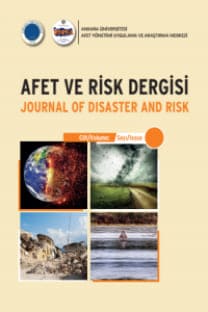İl Afet Risk Azaltma Planları (İRAP) Sonrası Yapılacak Risk Azaltma Yatırımlarında Best-Worst Metodu (BWM) ile Kriter Önceliklendirme
Afet Yönetimi, Risk Azaltma, İRAP, BWM, Yatırım
Criteria Prioritization with the Best-Worst Method (BWM) in Risk Reduction Investments After the Provincial Disaster Risk Reduction Plans (IRAP)
Disaster Management, Risk Reduction, IRAP, BWM, Investment,
___
- AFAD, (2019), İçişleri Bakanlığı Afet ve Acil Durum Yönetimi Başkanlığı, Stratejik Plan 2019- 2023. https://www.afad.gov.tr/kurumlar/afad.gov.tr/e_Kutuphane/Planlar/AFAD2019_2023-STRATEJIK-PLAN.pdf (Son Erişim Tarihi: 05.12.2021)
- Aitsi-Selmi, A., Blanchard, K., & Murray, V. (2016). Ensuring science is useful, usable and used in global disaster risk reduction and sustainable development: a view through the Sendai framework lens. Palgrave Communications, 2(1), 1-9. doi:10.1057/palcomms.2016.16.
- Briceño, S. (2015). What to expect after Sendai: Looking forward to more effective disaster risk reduction. International Journal of Disaster Risk Science, 6(2), 202-204. doi:10.1007/s13753-015-0047-4.
- Bucher, A., Collins, A., Taylor, B. H., Pan, D., Visman, E., Norris, J., ... & Murray, V. (2020). New partnerships for co-delivery of the 2030 agenda for sustainable development. International Journal of Disaster Risk Science, 11(5), 680-685. doi:10.1007/s13753-020-00293-8.
- Demir, G., & Gircan, H. (2020). Kriter ağırlıklandırma yöntemlerinden bwm ve fucom yöntemlerinin karşılaştırılması ve bir uygulama. Cumhuriyet Üniversitesi İktisadi ve İdari Bilimler Dergisi, 21(2), 170-185. https://doi.org/10.37880/cumuiibf.616766
- Faivre, N., Sgobbi, A., Happaerts, S., Raynal, J., & Schmidt, L. (2018). Translating the Sendai Framework into action: The EU approach to ecosystem-based disaster risk reduction. International journal of disaster risk reduction, 32, 4-10. doi:10.1016/j.ijdrr.2017.12.015.
- Isdr, U. (2005). Hyogo framework for action 2005-2015: building the resilience of nations and communities to disasters. In Extract from the final report of the World Conference on Disaster Reduction (A/CONF. 206/6) (Vol. 380). Geneva: The United Nations International Strategy for Disaster Reduction.
- İRAP (2020), İl Afet Risk Azaltma Planı Hazırlama Kılavuzu, AFAD Planlama ve Risk Azaltma Daire Başkanlığı, https://irap.afad.gov.tr/upload/Node/42062/files/I_RAP_KILAVUZ_tu_m_v9.pdf (Erişim tarihi: 08.10.2021).
- Min, Y., & Perucci, F. (2020). Impact of COVID-19 on SDG progress: a statistical perspective. United Nations Department of Economic and Social Affairs (UNDESA), New York
- Orhan, E. (2016). Building community resilience: business preparedness lessons in the case of Adapazarı, Turkey. Disasters, 40(1), 45-64. https://doi.org/10.1111/ disa.12132.
- Paton, D. (2008). Risk communication and natural hazard mitigation: how trust influences its effectiveness. International Journal of Global Environmental Issues, 8(1-2), 2-16. https://doi.org/10.1504/IJGENVI.2008.017256.
- Phibbs, S., Kenney, C., Severinsen, C., Mitchell, J., & Hughes, R. (2016). Synergising public health concepts with the Sendai framework for disaster risk reduction: A conceptual glossary. International journal of environmental research and public health, 13(12), 1241. doi:10.3390/ijerph13121241.
- Resmî Gazete, (2018), 4 sayılı Bakanlıklara Bağlı, İlgili, İlişkili Kurum ve Kuruluşlar ile Diğer Kurum ve Kuruluşların Teşkilatı Hakkında Cumhurbaşkanlığı Kararnamesi, 15/07/2018, Madde 52\2
- Rezaei, J. (2015). Best Worst Multi Criteria Decision Making Method. Omega, 53, 49-57. https://doi.org/10.1016/j.omega.2014.11.009
- Strateji ve Bütçe Başkanlığı (2019), 11. Kalkınma Planı (2019-2023), Türkiye Cumhuriyeti Cumhurbaşkanlığı, https://www.sbb.gov.tr/wp-content/uploads/2021/12/On_Birinci_Kalkinma_Plani-2019-2023.pdf (Erişim Tarihi: 05.01.2022)
- United Nations (2015). Sendai Framework for Disaster Risk Reduction 2015-2030, United Nations Office for Disaster Risk Reduction (UNISDR). http://www.unisdr.org/files/43291_sendaiframeworkfordrren.pdf.
- Yayın Aralığı: 4
- Başlangıç: 2018
- Yayıncı: Ankara Üniversitesi
Toplumda Afet Farkındalığı Oluşturmaya Yönelik Kullanılan Araçlar: Nitel Bir Çalışma
Ankara Batı Kesimi Zeminlerin Dinamik Özellikleri
Tolga KARABIYIKOĞLU, Ünal DİKMEN
İklim Değişikliği Türkiye’de Ekonomik Büyüme İçin Bir Risk Oluşturur mu?
Türkiye’de Yaşanan Doğa Kaynaklı Afetlerin Sosyo-Ekonomik Etkileri
İklim Değişikliğinin Yönetimi ve Tarım Sektörü
Kıvılcım Özge KARA, Ahmet Burçin YERELİ
Türkiye’de Etkin Bir Tsunami Erken Uyarı Sistemi ve Tsunami Risk Azaltımı İçin Gereksinimler
Van İli Kaya Düşmesi Duyarlılık Haritasının Oluşturulması ve Afetsellik Açısından Değerlendirilmesi
Sacit MUTLU, İshak CİNDİOĞLU, Azad Sağlam SELÇUK
1B ve 2B Taşkın Modellemesinin Karşılaştırılması: Fol Deresi Örneği
